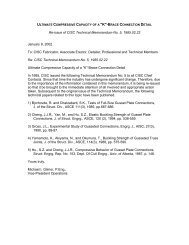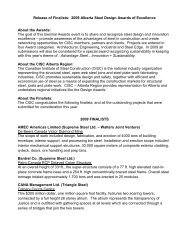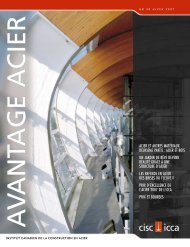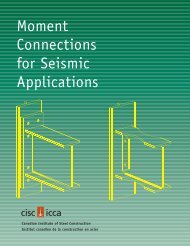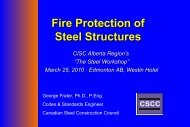FIRE PROTECTION OF STEEL STRUCTURES ... - CISC-ICCA
FIRE PROTECTION OF STEEL STRUCTURES ... - CISC-ICCA
FIRE PROTECTION OF STEEL STRUCTURES ... - CISC-ICCA
You also want an ePaper? Increase the reach of your titles
YUMPU automatically turns print PDFs into web optimized ePapers that Google loves.
Many organizations such as the SFPE have<br />
enhanced the dissemination of information<br />
related to fire protection engineering.<br />
Recently, collaboration among Building Code<br />
organizations in Australia (Building Codes<br />
Board), New Zealand (Department of Building<br />
and Housing), the United States (International<br />
Code Council) and Canada (National<br />
Research Council of Canada) has resulted in a<br />
500-page document entitled International Fire<br />
Engineering Guidelines that was published in<br />
2005 by the Australian Building Codes Board.<br />
These guidelines set the stage for more fire<br />
safety design of buildings by aiding both the<br />
authorities who approve building designs and<br />
the practitioners who are plying the relatively<br />
new approaches to fire protection engineering.<br />
In summary, designers, especially fire protection<br />
engineers, use PBD to demonstrate that buildings<br />
meet the fire safety levels required by the Code<br />
without adopting all of the prescriptive Code<br />
provisions. Most building designs still follow<br />
the prescriptive-based design requirements in<br />
NBCC’s Division B, Part 3, Fire Protection, Occupant Safety and<br />
Accessibility, however, there is a strong demand from design<br />
groups and developers to design some areas of buildings, such<br />
as main entrances and atriums, using fire protection engineered<br />
analysis as an alternative solution.<br />
There are many examples where a PBD approach has led to<br />
steel components in the building structure being designed to be<br />
unprotected or with a significant reduction in fire protection materials.<br />
The confluence of the release of the first objective based<br />
National Building Code of Canada (2005), the development<br />
of sophisticated modelling software and the expansion of the<br />
Fire Protection Engineering corps, provides expanded design<br />
possibilities for architects and their design team. Historic<br />
restrictions may now be reviewed in detail to ensure that safety<br />
is the first consideration for the team while opening opportunities<br />
for design flexibility. These alternative solutions add to the<br />
knowledge base and tools that are available to the architect and<br />
their design team.<br />
George S. Frater is Codes and Standards Engineer at the<br />
Canadian Steel Construction Council in Markham, ON.<br />
Carol Kleinfeldt is Principal at Kleinfledt Mychajlowycz Architects<br />
Inc. in Toronto, ON.<br />
S P R I N G 2 0 1 1 A D V A N T A G E S T E E L<br />
FiRE PROtEctiON<br />
Unprotected steel floor assembly using fire protection engineering<br />
ROUNDS - SQUARE - RECTANGULAR<br />
www.altitube.com<br />
2 1




